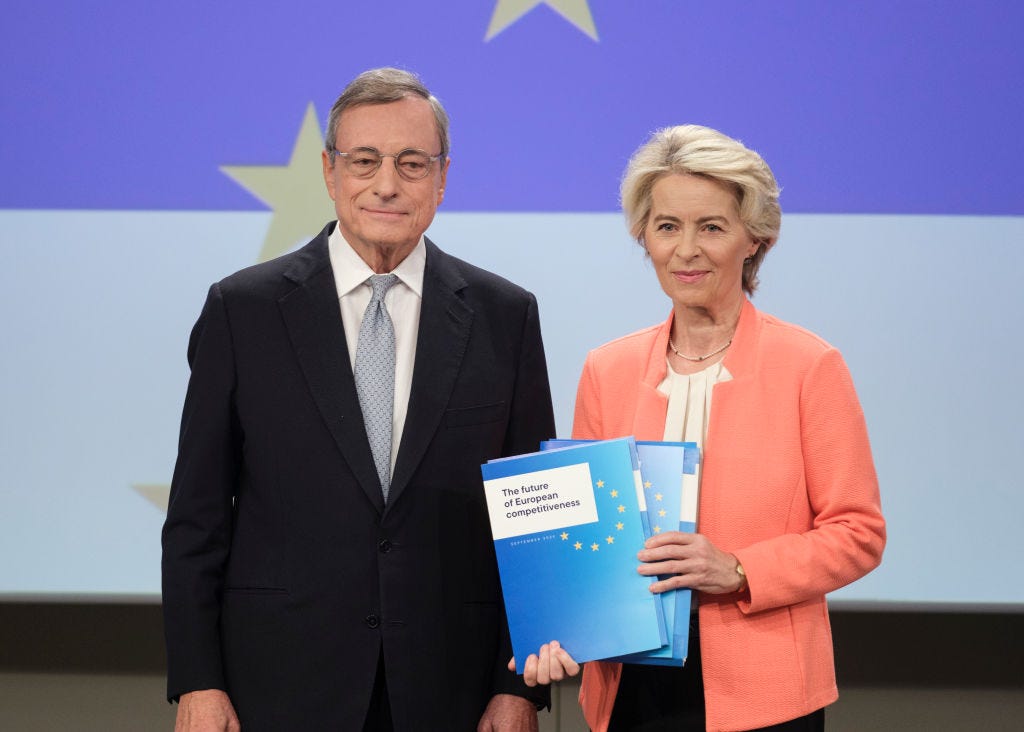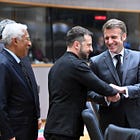The EU Is Stuck in Second Gear
The organization’s new budget is setting the continent on a path of genteel decline.
This article is brought to you by American Purpose, the magazine and community founded by Francis Fukuyama in 2020, which is proudly part of the Persuasion family.
The European Commission’s proposal for the EU’s new budget, unveiled in mid-July, can be best summarized by the old joke used by Woody Allen in the opening scene of Annie Hall: “Two elderly women are at a Catskill mountain resort, and one of ‘em says, ‘Boy, the food at this place is really terrible.’ The other one says, ‘Yeah, I know; and such small portions.’”
Envisaged to provide for the EU’s needs between 2028 and 2034, the so-called Multiannual Financial Framework (MFF) is indeed modest in size. It amounts to a total of €2 trillion, or 1.3 percent of the EU’s expected GDP on an annualized basis. There are some good things about the proposal, most notably the flexibility to move funds to address new challenges that will inevitably arise over the next seven years. However, the proposed budget also provides too much business-as-usual at the expense of bolder action to address Europe’s most pressing challenges.
To an American ear, a discussion of the EU’s seven-year budget plan may sound terribly esoteric. Yet what seems like Brussels inside baseball does matter. Whether we want Europe to play a bigger role on the world stage or reduce it to the status of a U.S. dependency, the budgetary choices made by the EU will shape the future of the continent and also its posture toward the United States.
Somewhat unsurprisingly, the single biggest item in the budget, at €865 billion, is the EU’s program of agricultural subsidies—a form of redistribution to an extremely well-organized interest group. A politics of redistribution, rather than of producing public goods, has always been a part of the project. The Commission’s proposal, moreover, is just an opening bid. The horse-trading that will ensue starting this fall might make the budget bigger—though it might not, depending on the power of the more frugal states. It will, however, almost certainly make the budget more accommodative to parochial demands as opposed to a higher-level conception of European interest.
As a sign of the unsavory compromises that will likely need to be made, Hungary’s Viktor Orbán has already vowed to veto the new MFF unless the Commission unfreezes the remaining funds that have been blocked under the EU’s Rule of Law Conditionality Regulation. As of now, Hungary is being prevented from accessing around €18 billion of some €50 billion it was allocated in the current MFF, running from 2021-2027, because of the country’s persistent democratic erosion and corruption. The new MFF imposes even stricter requirements on the disbursement of funds—requiring countries such as Hungary to receive an annual bill of democratic health before accessing much of the largesse offered by the EU.
As an aside, the experience with the Regulation, which empowers the Commission to freeze funding to the EU’s troublemakers, has been mixed. On the one hand, it has given EU institutions leverage that they previously lacked—arguably helping to prevent countries such as Slovakia or Poland from going fully down the road of Hungary. On the other hand, it has also given Orbán leverage over the rest of the EU on decisions that require unanimity. His brinkmanship has slowed down the rollout of sanctions against Russia as well as progress in rolling out additional support for Ukraine. And while the frustration with Hungary is growing, the next budget cycle risks looking very similar to the current one—especially if Orbán is reelected as prime minister next year.
As the fight over who gets what intensifies, the bloc risks losing sight of the two fundamental challenges it faces. First, it has to re-arm quickly, both to deter Russia and to fill the void left by an increasingly unreliable United States. Two, the continent is in a bad economic place, combining slow growth rates and large debt burdens, which limit the space for expanding defense spending, among other priorities. This year, like in 2024, growth is expected to be a meagre 1 percent, outpaced by inflation.
Poor growth, among other considerations, played a role in the European Commission’s decision to accommodate Donald Trump during the recent trade negotiations, which essentially ratified a 15 percent U.S. tariff on European exports to the United States, and extracted a further financial tribute from America’s European allies.
There will be a backlash against the humiliation inflicted by Washington. Yet the outcome of negotiations reflects Europe’s relative weakness—itself a function of bad policy choices, which could still be overcome, including by bolder action by European institutions.
In past times of economic distress, the EU acted as a “deus ex machina” of sorts, providing liquidity during the Covid pandemic through a new borrowing facility and keeping debt vigilantes at bay by letting the European Central Bank make large purchases of government bonds. Such ad hoc interventions have been rightly criticized, especially because they took place outside of a well-designed, federalist system of rules. Yet they also served their purpose, albeit imperfectly.
There can be no question that Europe finds itself in a crisis again, in part due to adverse geopolitics and in part due to the calamitous state of national public finances. To re-arm and to plug the investment gap—one of the prerequisites for faster growth according to the 2024 Draghi report on EU competitiveness—the EU needs additional fiscal firepower, beyond contributions made by member governments. It must also use new resources wisely, instead of just perpetuating legacy policies and programs. Alas, while the new MFF is a natural opportunity for progress, the early proposal fails on both fronts. If adopted, it risks setting Europe on a path of decline—and EU institutions on a path to irrelevance—as European governments will be inclined to take matters into their own hands.
The Commission is taking some pride in the fact that the MFF “will allocate €131 billion to support investment in defense, security and space, five times more funding at EU level compared to the previous MFF.” Annualized, that amounts to a little more than half of Italy’s defense budget—far from the game-changer Europe needs. The amount also adds to the €150 billion that has already been allocated through ReArm Europe, a new financing facility created in the aftermath of Russia’s full-scale invasion of Ukraine. That money, however, simply adds to the public debt of individual member states, albeit at lower borrowing costs available to the Commission. What Europe needs is more resources, raised without putting national public finances in peril—and these resources also need to be better spent, building real capability instead of, say, a bridge to Sicily.
Neither is the new MFF doing much for Europe’s competitiveness. The Draghi report urged the EU to close its large investment gap in infrastructure, R&D, energy, and other areas. The €700 billion, earmarked for decarbonization across different spending programs, will involve investment to much-needed projects of cross-border connectivity. There is no ambition, however, to usher in an age of energy abundance—for example by committing to building a European fleet of nuclear reactors. Meanwhile, energy prices in the EU remain chronically higher than those in the United States and China, putting European manufacturing in a difficult spot.
Horizon Europe, the EU’s main R&D program, is worth €175 billion, to be spent over a 7-year horizon. The EU spends some €381.4 billion on private and public research every year, making the EU’s own contribution appear very modest—particularly if the aim is to catch up with, or overtake, the United States and China.
There are other shortcomings. Ukraine has the ambition to join the EU by the end of this decade. While the draft budget references the EU’s support for Ukraine, it does not lay much preparatory groundwork for Ukraine as a member state during the upcoming budget cycle. To be sure, political decisions surrounding the accession go beyond the mandate of the Commission in drafting a new budget—there would likely be transitional periods imposed on Ukraine’s access to agricultural subsidies, or even a larger overhaul of the bloc’s Common Agricultural Policy. Yet it is striking not to see the reconstruction and economic development of a purported future member state—and a sizable one at that—as an explicit item in a document that is meant to be forward-looking.
In many polities, instances of international humiliation prompt pressure for change. The Commission’s acquiescence to a grotesquely one-sided trade deal with the United States was one such instance. One can only hope that it will be enough to produce a momentum for change. However, Europe’s political landscape does not offer grounds for optimism. For example, there are very few people advocating for a genuine “abundance” agenda, to borrow a catchphrase from America’s recent supply-side manifesto. Behind the surface of declared support for Ukraine, there are also genuine differences in the urgency with which member states believe that a revanchist Russia and a retreating America are a threat to their own security—as well as real obstacles to Ukraine’s accession on the ambitious timeframe currently envisaged.
If the EU remains on technocratic autopilot (as seems likely under the terms of this MFF), only occasionally disturbed by spouts of resurgent nationalist euroscepticism, slow decline and irrelevance are the more benign of its possible futures. The more worrying, yet perfectly thinkable, possibility is that of Europe’s gradual balkanization and conflict. It is not too late to change course. Here’s to hoping that the upcoming fight over the final EU budget will do exactly that.
Dalibor Rohac is a senior fellow at the American Enterprise Institute in Washington, D.C.
Follow Persuasion on Twitter, LinkedIn, and YouTube to keep up with our latest articles, podcasts, and events, as well as updates from excellent writers across our network.
And, to receive pieces like this in your inbox and support our work, subscribe below:






